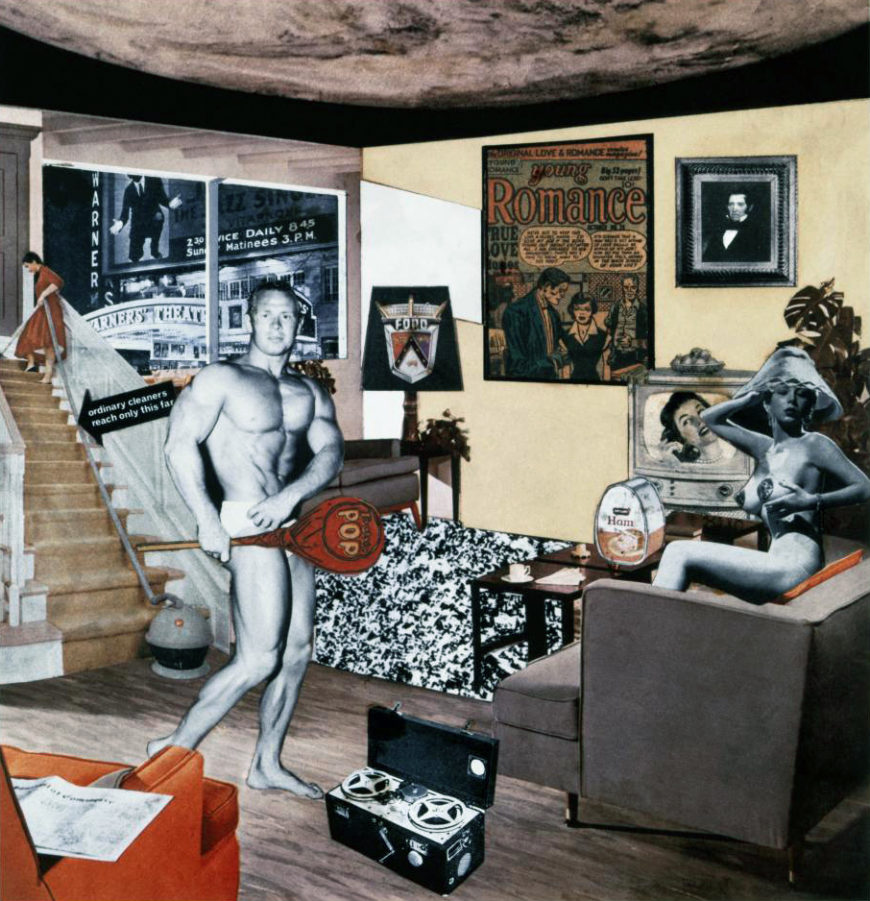Richard Hamilton, Just What it is That Makes Today’s Homes so Different, so Appealing?

In this iconic collage by the British artist Richard Hamilton, created in 1956, a midcentury living room is filled to the brim with logos and cut-out images of consumer products. At center, a lampshade is emblazoned with the emblem for the auto manufacturer, Ford. The cover of a comic book hangs as “wall-art” and a can of tinned ham sits on the coffee table, like a decorative vase. Found images and mass media artifacts are everywhere we look in this image—on the television, out the window, up the stairs, and on the floor.

In fact, even the couple who occupy the room appear to us as commodities. The wife, a nude model, is perched seductively on the couch, while the husband, a Herculean body builder, shows off his covetable physique, wielding a suggestive Tootsie pop by his waist. Often interpreted as a kind of idealized, modern-day “Adam and Eve,” the couple are also products on display, no different from the branded and packaged goods that adorn their home.
The title of this art work takes the form of a question—Just What is It That Makes Today’s Homes So Different, so Appealing?—phrasing that echoes the titles of articles in popular magazines and which can be answered somewhere in the dizzying array of consumer imagery strewn across its the work’s surface. The domestic space, Hamilton asserts, has become prime real estate for the advertising industry, and is an arena in which middle class aspirations are on full display in the form of futurist vacuum cleaners and television sets.
It was Hamilton who gave the movement its first official definition. Describing his ideas to his friends, the architects Peter and Alison Smithson, Hamilton wrote:
Pop Art is: Popular (designed for a mass audience), Transient (short-term solution), Expendable (easily forgotten), Low cost, Mass produced, Young (aimed at youth), Witty, Sexy, Gimmicky, Glamorous, Big business
Richard Hamilton, Letter to Peter and Alison Smithson, 16 January 1957
The terms above were rarely used in relation to fine art, which is normally ascribed a sense of timelessness, seriousness of purpose, and significant material value. Pop artists sought to challenge the elitism of the academic tradition, much like the artists of the Dada movement of the World War I era, who challenged the way in which art is often used as a symbol of socio-economic status. Pop artists were interested in critiquing the status of art as a commodity object, and often depicted or made use of artifacts of popular culture, advertisements, and mass media.
While Just What is It… is considered to be among the most foundational works of Pop Art, this small collage was initially not created as a work of art. At just 12 inches square, it was produced as the cover design for the catalogue of an exhibition called This is Tomorrow, an immersive, collaboratively produced installation of art and design that was conceived by a collective called The Independent Group, of which Hamilton was part.[1]
- Dr. Allison Young, "Richard Hamilton, Just What is It That Makes Today’s Homes So Different, so Appealing?," in Smarthistory, December 6, 2021, accessed May 24, 2023, https://smarthistory.org/richard-hamilton-just-what-is-it/ ↵

